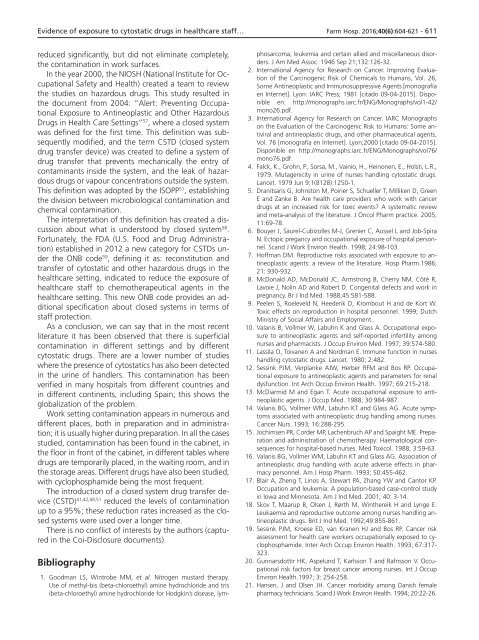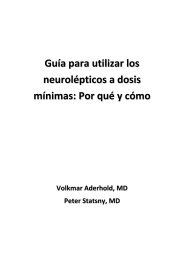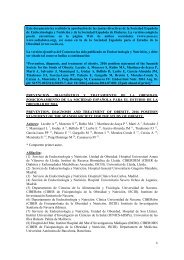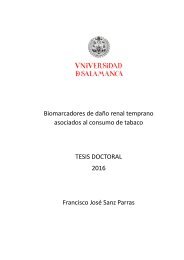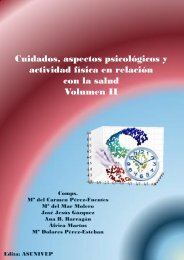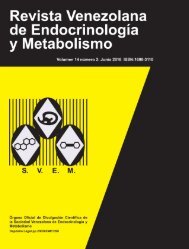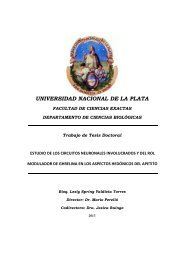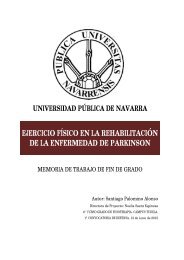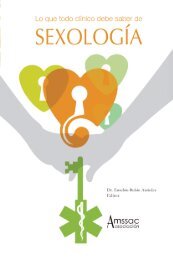Noviembre-Diciembre
156_v40n6(1)
156_v40n6(1)
Create successful ePaper yourself
Turn your PDF publications into a flip-book with our unique Google optimized e-Paper software.
Evidence of exposure to cytostatic drugs in healthcare staff… Farm Hosp. 2016;40(6):604-621 - 611<br />
reduced significantly, but did not eliminate completely,<br />
the contamination in work surfaces.<br />
In the year 2000, the NIOSH (National Institute for Occupational<br />
Safety and Health) created a team to review<br />
the studies on hazardous drugs. This study resulted in<br />
the document from 2004: “Alert: Preventing Occupational<br />
Exposure to Antineoplastic and Other Hazardous<br />
Drugs in Health Care Settings” 57 , where a closed system<br />
was defined for the first time. This definition was subsequently<br />
modified, and the term CSTD (closed system<br />
drug transfer device) was created to define a system of<br />
drug transfer that prevents mechanically the entry of<br />
contaminants inside the system, and the leak of hazardous<br />
drugs or vapour concentrations outside the system.<br />
This definition was adopted by the ISOPP 51 , establishing<br />
the division between microbiological contamination and<br />
chemical contamination.<br />
The interpretation of this definition has created a discussion<br />
about what is understood by closed system 58 .<br />
Fortunately, the FDA (U.S. Food and Drug Administration)<br />
established in 2012 a new category for CSTDs under<br />
the ONB code 59 , defining it as: reconstitution and<br />
transfer of cytostatic and other hazardous drugs in the<br />
healthcare setting, indicated to reduce the exposure of<br />
healthcare staff to chemotherapeutical agents in the<br />
healthcare setting. This new ONB code provides an additional<br />
specification about closed systems in terms of<br />
staff protection.<br />
As a conclusion, we can say that in the most recent<br />
literature it has been observed that there is superficial<br />
contamination in different settings and by different<br />
cytostatic drugs. There are a lower number of studies<br />
where the presence of cytostatics has also been detected<br />
in the urine of handlers. This contamination has been<br />
verified in many hospitals from different countries and<br />
in different continents, including Spain; this shows the<br />
globalization of the problem.<br />
Work setting contamination appears in numerous and<br />
different places, both in preparation and in administration;<br />
it is usually higher during preparation. In all the cases<br />
studied, contamination has been found in the cabinet, in<br />
the floor in front of the cabinet, in different tables where<br />
drugs are temporarily placed, in the waiting room, and in<br />
the storage areas. Different drugs have also been studied,<br />
with cyclophosphamide being the most frequent.<br />
The introduction of a closed system drug transfer device<br />
(CSTD) 41,42,49,51 reduced the levels of contamination<br />
up to a 95%; these reduction rates increased as the closed<br />
systems were used over a longer time.<br />
There is no conflict of interests by the authors (captured<br />
in the Coi-Disclosure documents).<br />
Bibliography<br />
1. Goodman LS, Wintrobe MM, et al. Nitrogen mustard therapy.<br />
Use of methyl-bis (beta-chloroethyl) amine hydrochloride and tris<br />
(beta-chloroethyl) amine hydrochloride for Hodgkin’s disease, lymphosarcoma,<br />
leukemia and certain allied and miscellaneous disorders.<br />
J Am Med Assoc. 1946 Sep 21;132:126-32.<br />
2. International Agency for Research on Cancer. Improving Evaluation<br />
of the Carcinogenic Risk of Chemicals to Humans, Vol. 26,<br />
Sorne Antineoplastic and Irnmunosuppressive Agents [monografía<br />
en Internet]. Lyon: IARC Press; 1981 [citado 09-04-2015]. Disponible<br />
en: http://monographs.iarc.fr/ENG/Monographs/vol1-42/<br />
mono26.pdf.<br />
3. International Agency for Research on Cancer. IARC Monographs<br />
on the Evaluation of the Carcinogenic Risk to Humans: Some antiviral<br />
and antineoplastic drugs, and other pharmaceutical agents,<br />
Vol. 76 [monografía en Internet]. Lyon;2000 [citado 09-04-2015].<br />
Disponible en http://monographs.iarc.fr/ENG/Monographs/vol76/<br />
mono76.pdf.<br />
4. Falck, K., Grohn, P., Sorsa, M., Vainio, H., Heinonen, E., Holsti, L.R.,<br />
1979. Mutagenicity in urine of nurses handling cytostatic drugs.<br />
Lancet. 1979 Jun 9;1(8128):1250-1.<br />
5. Dranitsaris G, Johnston M, Poirier S, Schueller T, Milliken D, Green<br />
E and Zanke B. Are health care providers who work with cancer<br />
drugs at an increased risk for toxic events? A systematic review<br />
and meta-analysis of the literature. J Oncol Pharm practice. 2005;<br />
11:69-78.<br />
6. Bouyer J, Saurel-Cubizolles M-J, Grenier C, Aussel L and Job-Spira<br />
N. Ectopic pregancy and occupational exposure of hospital personnel.<br />
Scand J Work Environ Health. 1998; 24:98-103.<br />
7. Hoffman DM. Reproductive risks associated with exposure to antineoplastic<br />
agents: a review of the literature. Hosp Pharm.1986;<br />
21: 930-932.<br />
8. McDonald AD, McDonald JC, Armstrong B, Cherry NM, Côté R,<br />
Lavoie J, Nolin AD and Robert D. Congenital defects and work in<br />
pregnancy. Br J Ind Med. 1988;45:581-588.<br />
9. Peelen S, Roeleveld N, Heederik D, Krombout H and de Kort W.<br />
Toxic effects on reproduction in hospital personnel. 1999; Dutch<br />
Ministry of Social Affairs and Employment..<br />
10. Valanis B, Vollmer W, Labuhn K and Glass A. Occupational exposure<br />
to antineoplastic agents and self-reported infertility among<br />
nurses and pharmacists. J Occup Environ Med. 1997; 39:574-580.<br />
11. Lassila O, Toivanen A and Nordman E. Immune function in nurses<br />
handling cytostatic drugs. Lancet. 1980; 2:482.<br />
12. Sessink PJM, Verplanke AJW, Herber RFM and Bos RP. Occupational<br />
exposure to antineoplastic agents and parameters for renal<br />
dysfunction. Int Arch Occup Environ Health. 1997; 69:215-218.<br />
13. McDiarmid M and Egan T. Acute occupational exposure to antineoplastic<br />
agents. J Occup Med. 1988; 30:984-987.<br />
14. Valanis BG, Vollmer WM, Labuhn KT and Glass AG. Acute symptoms<br />
associated with antineoplastic drug handling among nurses.<br />
Cancer Nurs. 1993; 16:288-295.<br />
15. Jochimsen PR, Corder MP, Lachenbruch AP and Spaight ME. Preparation<br />
and administration of chemotherapy: Haematological consequences<br />
for hospital-based nurses. Med Toxicol. 1988; 3:59-63.<br />
16. Valanis BG, Vollmer WM, Labuhn KT and Glass AG. Association of<br />
antineoplastic drug handling with acute adverse effects in pharmacy<br />
personnel. Am J Hosp Pharm. 1993; 50:455-462.<br />
17. Blair A, Zheng T, Linos A, Stewart PA, Zhang YW and Cantor KP.<br />
Occupation and leukemia: A population-based case-control study<br />
in Iowa and Minnesota. Am J Ind Med. 2001; 40: 3-14.<br />
18. Skov T, Maarup B, Olsen J, Rørth M, Winthereik H and Lynge E.<br />
Leukaemia and reproductive outcome among nurses handling antineoplastic<br />
drugs. Brit J Ind Med. 1992;49:855-861.<br />
19. Sessink PJM, Kroese ED, van Kranen HJ and Bos RP. Cancer risk<br />
assessment for health care workers occupationally exposed to cyclophosphamide.<br />
Inter Arch Occup Environ Health. 1993; 67:317-<br />
323.<br />
20. Gunnarsdottir HK, Aspelund T, Karlsson T and Rafnsson V. Occupational<br />
risk factors for breast cancer among nurses. Int J Occup<br />
Environ Health.1997; 3: 254-258.<br />
21. Hansen, J and Olsen JH. Cancer morbidity among Danish female<br />
pharmacy technicians. Scand J Work Environ Health. 1994; 20:22-26.


